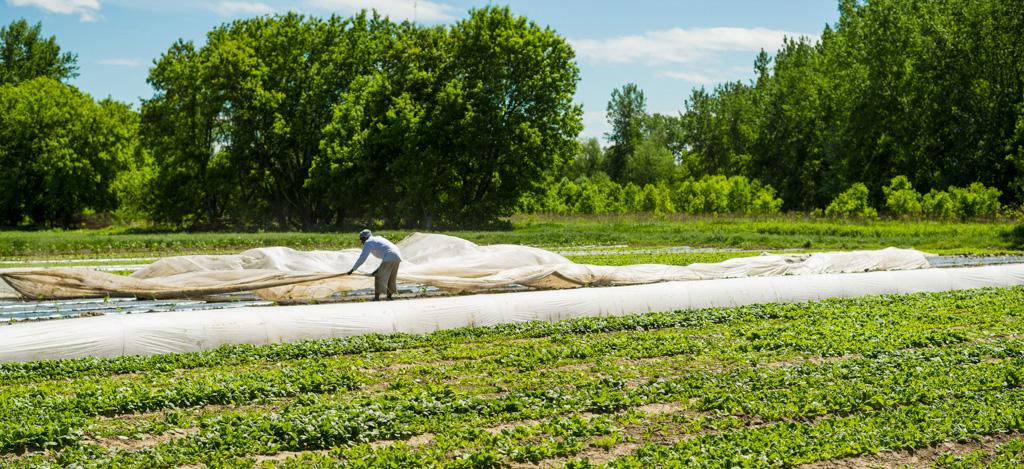Sitting in the 100-year old Farm Barn at Shelburne Farms during a two-day course on Carbon Farming with Eric Toensmeier, I couldn’t help but ponder how simple life’s decisions must have been for the folks who lived and tended this barn back then. The questions that we as individuals and as a society need to face are now intricately linked to the health of our planet and the success of future generations.
Our society is currently facing a climate crisis of epic proportions: hunger, drought, extreme storms, flooding, and unpredictable weather. With our current agricultural system contributing about half of the worldwide emissions, I was intrigued when I heard that Toensmeier had some answers on how farming could be part of the climate solution. Based on Toesnmeier’s research, he argues that when we combine immense reductions in fossil fuel emissions and adaptation strategies, carbon farming has the potential to return carbon dioxide in our atmosphere to safe levels all while feeding people, providing ecosystem services as a public good, and building healthy soils for future generations.
The workshop reviewed various farming practices, some of which are used by the majority of farmers in the United States, other practices that are used by a majority of the world but are unfamiliar to our culture and even more that are being used on an experimental basis. To begin, the production, processing and distribution of food is the world’s largest economic activity. Currently the food system is responsible for nearly half of all greenhouse gas emissions worldwide. But emissions that result directly from agricultural production account for 11-15 percent of total greenhouse gas emissions. The fossil fuels that power farms are the worst culprits; in the form of agrochemicals, plowing and subsoiling, harvesting with combines and pumping water for irrigation. The other 35 percent of carbon emissions are due to processing, refrigerating, packing, retailing, food waste, and deforestation of land for agricultural use. Of all the aforementioned impacts, agriculture’s greatest impact on climate change is the release of carbon held in the soil, primarily from deforestation and land clearing. Changes in land use exposes soil organic carbon to oxygen in the air, converting it to carbon dioxide. Plowing, or tillage, in particular, is highly destructive of soil organic carbon, although this varies by ecosystem, soil type and farming practice. In temperate climates, like Vermont and the Northeast, soil loses 30-50 percent of its organic carbon by the time it has been cultivated for 50 years, compared to only 10 years of cultivation in tropical climates. And our soil loses even more from eroded or degraded soils. All this degradation of soils has another impact- reduced productivity of the farmland itself. The good news is that agriculture doesn’t need to contribute to climate change, but can actually reduce emissions by sequestering billions of tons of atmospheric carbon by trapping it in the soil and aboveground biomass.
Step 1: Reduce our Agricultural Emissions
We can reduce carbon emissions from soil by 1) slowing or stopping land clearing and wetland drainage for agriculture, 2) preventing erosion to reverse the degradation of agricultural soils and 3) reducing tillage. We can reduce fossil fuel consumption by cutting back on mechanized equipment use and reducing the application of chemical nitrogen fertilizers. We can further reduce emissions from chemical fertilizers by using them more efficiently with better timing and applying appropriate amounts, or by replacing them with manure or nitrogen-fixing plants such as legume cover crops or agroforestry support trees. Agroforestry is the intentional, intensive, integrated, and interactive integration of trees with crops, often annuals.
Step 2: Agroecological Intensification
Unfortunately, industrial agriculture’s gains in yield have come at a huge social and ecological cost. This includes costs such as emissions from the production and use of synthetic nitrogen fertilizers in our industrial agricultural system. In 2013, the United Nations Conference on Trade and Development came out strongly in favor of agroecological intensification and strongly oppose the industrial food system in favor of a system that wouldn’t sacrifice people or ecosystems for yields. But can agroecological farming provide yields that are comparable to our current industrial baseline and while preventing land clearing? The answer to this question varies considerably depending on the location and systems employed, but studies have shown that once agroecological systems have been established (which can take years), they often yield better than industrial agriculture. One study by Jules Pretty of the University of Essex in the United Kingdom, reviewed 286 sustainable agriculture projects spanning 37 million hectares, 12.6 million farms, and 3 percent of all cropland in developing countries, and found that at a conservative rate of less than 1 ton/ha/acre, these projects were estimated to sequester 11.4 million tons of carbon annually with an average increase in yield of 79 percent. The projects agroecological intensification in the form of integrated pest management, integrated nutrient management, conservation tillage, agroforestry, aquaculture, water harvesting, and livestock integration. Polycultures, which are the integration of multiple crops in the same area, are another great example of agroecological intensification. A study in France found that the yield of 247 acres of timber trees intercropped with cereals would require 321-346 acres of separate monocultures of timber and cereals. Although these studies are encouraging, and in many cases agroecological production can yield as well or better than the status quo, we shouldn’t assume that this is a silver bullet and is always appropriate to our region and landforms. It is also important to note that although yield is a critical factor, so are social implications, economics, ecosystem services, and carbon sequestration capacity.
Organic Annual Cropping Systems and the Role of Certification
Currently Vermont employs mainly annual cropping systems and pasture management techniques throughout the state. They are the primary source of human food and the primary source of concentrated feed for livestock. These techniques include cover cropping and crop rotation and have very low to low rates of sequestration. Organic and agroecological approaches to annual cropping sequester carbon at a higher rate and have low to medium rates of sequestration, and it has been shown that organic production systems generally have higher soil organic carbon than conventional/chemical systems. The Rodale Institute has proposed the term regenerative organic production, which includes cover crops, compost application, and crop rotation. Silvoarable agroforestry systems integrate trees with annual crops. This includes strip intercropping, alley cropping, evergreen agriculture and other practices. These practices represent a significant improvement over annual cropping alone and don’t require major shifts in diet, farm mechanization, or the food system.
The Northeast Organic Farming Association of Vermont (NOFA-VT) and Vermont Organic Farmers (VOF), the certification program of NOFA-VT, support farmers using regenerative practices to build soil organic matter and replace and store carbon in the soil through biologically active and healthy soils. Organic standards specifically address soil quality and regeneration through certification requirements. These include:
Soil fertility and crop nutrient management practices: Certified farmers must implement tillage and cultivation practices that either maintain or improve the physical, chemical and biological condition of soil and minimize soil erosion.
Crop rotation practice: Certified farmers must implement a crop rotation that will either maintain/improve soil organic matter, provide pest management, manage nutrients, and provide erosion control.
By implementing some of these experimental practices, such as agroforestry and silvopasture systems, into the organic certification framework, we can begin to create a farming culture that creates healthy, biologically active soils, that addresses the use of persistent pesticides, GMOs, animal welfare, habitat protection, ecosystem health, and sequesters carbon while mitigating climate change.
Next Steps for Vermont and the Northeast
In order to begin working on a solution for both the climate and working farms in Vermont, we need several approaches. First of all, we need to create a systematic and universal approach to measuring carbon across the region and internationally, on different farms, so we can start creating baselines and track improvements. This is the most important first step because carbon in soil is notoriously promiscuous, does not remain in the same location, and is easily returned to the atmosphere. We need the means to truly measure long term carbon gains on farms and forestry operations. Once this system is established, we should then begin to think critically about the benefits of a carbon tax. We should be incentivizing carbon sequestration by our farmers and utilizing their sequestration capacity. However as of now, there are no economic incentives for farmers to invest in these types of farming systems. With a carbon tax on polluters, we could utilize these funds to pay farmers while polluters are deterred from contributing to greenhouse gas emissions. We can begin to either pay farmers by unit of carbon sequestered or for implementing farming practices that sequester carbon over the long-term by providing ecosystem services and a public good in the form of mitigating climate change.
On a state level, modifying the new Required Agricultural Practices and Current Use Program would be great starting points for promoting these initiatives. Specific practices that build soil organic matter and maintain biologically active soils could be included in the VAAFM’s new Required Agricultural Practices. They could be expanded to include additional regenerative organic practices that would include incentives for farmers to adopt them. And the state’s current use program should begin to revise their criteria for eligibility by encouraging silvopasture and agroforestry systems as both an agricultural and forestry enterprise. Finally, we need more education and awareness of these topics. If preliminary studies have already shown that agroecological intensification, in the form of polycultures and alley cropping, have the potential to generate better yields than our typical monocultures, then every farm should be supported to implement these techniques on their farm.
As the crisis of climate change continues to threaten our world, it’s hard to visualize solutions that are win-win for everyone involved. Compromises will have to be made, but carbon farming will be an important and large piece of the puzzle in combating climate change. And just like Shelburne Farm’s 100-year old barn, I hope to leave future generations with as much hope for the future as those old hand-hewn beams gave me as I listened to Eric Toesnmeier provide solutions for our farming community.
SOURCE: Toesnmeier, Eric. “The Carbon Farming Solution: A Global Toolkit of Perennial Crops and Regenerative Agriculture Practices for Climate Change Mitigation and Food Security.” February 22, 2016.

